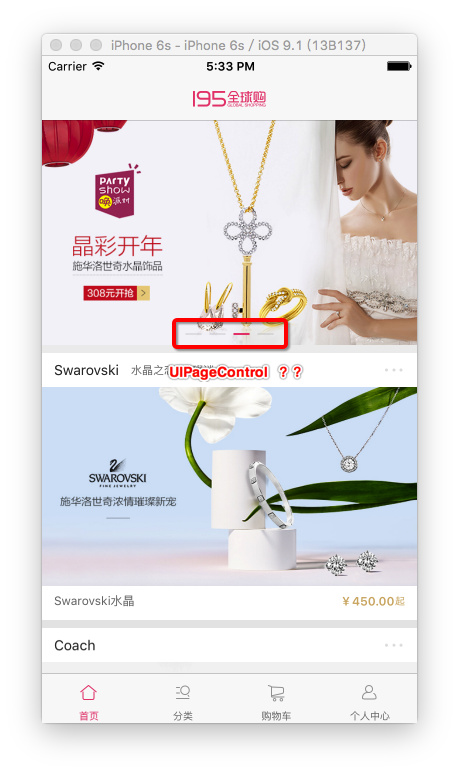iOS底层-KVC使用实践以及实现原理
发布于 2016-03-30 05:14:06 | 291 次阅读 | 评论: 0 | 来源: 分享
iOS苹果移动操作系统
苹果iOS是由苹果公司开发的移动操作系统。苹果公司最早于2007年1月9日的Macworld大会上公布这个系统,最初是设计给iPhone使用的,后来陆续套用到iPod touch、iPad以及Apple TV等产品上。
原文出处: Coder_CYX (@Coder_陈燕翔 )
简介
KVC(Key-value coding)键值编码,顾名思义。额,简单来说,是可以通过对象属性名称(Key)直接给属性值(value)编码(coding)
“编码”可以理解为“赋值”。这样可以免去我们调用getter和setter方法,从而简化我们的代码,也可以用来修改系统控件内部属性(这个黑魔法且用且珍惜)。
1. 最简单的使用例子
- 假设有
CYXModel类与CYXShopModel类,CYXModel里面有name、product属性,CYXShopModel里面有productName属性。@interface CYXModel: NSObject @property (nonatomic, strong) NSString *name; @property (nonatomic, strong) CYXShopModel *product; @end@interface CYXShopModel: NSObject @property (nonatomic, strong) NSString * productName; @end- 不使用KVC,我们这样访问
CYXModel的属性- 取值:
CYXModel *model = [[CYXModel alloc]init]; NSString *name = model. name; CYXShopModel *shop = model. product; NSString *productName = shop. productName; - 设值:
CYXModel *model = [[CYXModel alloc]init]; model. name = @"CYX"; CYXShopModel *shopModel = [[CYXShopModel alloc]init]; shopModel. productName = @"NIKE"; model. product = shopModel;
- 取值:
- 使用KVC,我们可以这样访问
CYXModel的属性- 取值:
CYXModel *model = [[CYXModel alloc]init]; NSString *name = [model valueForKey: @"name" ]; NSString *productName = [model valueForKeyPath: @"product.productName" ]; - 设值:
CYXModel *model = [[CYXModel alloc]init]; [model setValue:@"CYX" forKey:@"name"]; [model setValue:@"NIKE" forKeyPath:@"product.productName"];
- 取值:
注: 这个简单的例子,可能你看了觉得这并没什么卵用,下面我们来分析一下稍微有点卵用的例子吧。
2. KVC字典转模型的实现原理
- 假设dict字典中有name,icon的Key,CYXModel模型类中必须要有同名的name,icon属性与之相对应。
- 我们使用
[CYXModel setValuesForKeysWithDictionary:dict];进行字典转模型。 setValuesForKeysWithDictionary:方法内部实现原理如下:- (1) 遍历字典里面所有的key和值,name,icon。
// enumerateKeysAndObjectsUsingBlock:遍历字典中的所有keys和valus [dict enumerateKeysAndObjectsUsingBlock:^(id key, id obj, BOOL *stop) { // 利用KVC给模型中属性赋值,, // key:用来给哪个属性 // Value:给模型的值 [CYXModel setValue:obj forKey:key]; }]; - (2) 分别给属性赋值
[CYXModel setValue:dict[@"name"] forKey:@"name"];[CYXModel setValue:dict[@"icon"] forKey:@"icon"];
- (1) 遍历字典里面所有的key和值,name,icon。
setValue:forKey:方法:给模型的属性赋值- 赋值原理:
- (1)去模型中查找有没有
setIcon方法,就直接调用这个set方法,给模型这个属性赋值[self setIcon:dict[@"icon"]]; - (2)如果找不到set方法,接着就会去寻找有没有
icon属性,如果有,就直接访问模型中icon = dict[@"icon"]; - (3)如果找不到icon属性,接着又会去寻找
_icon属性,如果有,直接_icon = dict[@"icon"]; - (4)如果都找不到就会报错
[<Flag 0x7fb74bc7a2c0> setValue:forUndefinedKey:]
- (1)去模型中查找有没有
- 赋值原理:
- 扩展:读者可以去查查KVV(键值验证),进一步理解报错原因与容错方法。
注: 稍微有点卵用的看完,接下来说一个比较有卵用的用法,这个例子需要配合runtime来实现,有兴趣可以看看,runtime内容不少,这里就暂不介绍了,欢迎 关注,在下篇文字小结一下runtime。
3. 修改系统控件内部属性(runtime + KVC)
- 有时候,UI会闲着没事,会给你找点事情,例如,界面设计图是这样的:
 必奢商城首页
必奢商城首页 - 这。。怎么感觉有点不同,这
UIPageControl怎么跟我平常用的不一样?平常不都是这样的??如下图 美丽说首页
美丽说首页 - 首先想到的肯定是,查看
UIPageControl的头文件,如下:NS_CLASS_AVAILABLE_IOS(2_0) @interface UIPageControl : UIControl @property(nonatomic) NSInteger numberOfPages; // default is 0 @property(nonatomic) NSInteger currentPage; // default is 0. value pinned to 0..numberOfPages-1 @property(nonatomic) BOOL hidesForSinglePage; // hide the the indicator if there is only one page. default is NO @property(nonatomic) BOOL defersCurrentPageDisplay; // if set, clicking to a new page won't update the currently displayed page until -updateCurrentPageDisplay is called. default is NO - (void)updateCurrentPageDisplay; // update page display to match the currentPage. ignored if defersCurrentPageDisplay is NO. setting the page value directly will update immediately - (CGSize)sizeForNumberOfPages:(NSInteger)pageCount; // returns minimum size required to display dots for given page count. can be used to size control if page count could change @property(nullable, nonatomic,strong) UIColor *pageIndicatorTintColor NS_AVAILABLE_IOS(6_0) UI_APPEARANCE_SELECTOR; @property(nullable, nonatomic,strong) UIColor *currentPageIndicatorTintColor NS_AVAILABLE_IOS(6_0) UI_APPEARANCE_SELECTOR; @end
- 卧槽,就这么几个属性可以给我设的,不够用啊兄弟。能不能给我个可以赋值
UIImage对象的属性?看来正常途径使用系统的控件是设不了了,剩下的我感觉只有两种方法(如有其它,欢迎指出),一种是自定义PageControl,这种方式看起来不简单,各位有兴趣可以去试试。另一种方式就是,通过runtime遍历出UIPageControl所有属性(包括私有成员属性,runtime确实很强大)。 - 使用runtime遍历
UIPageControl结果(下篇文字再谈谈runtime,这里暂不解释)如下打印:2016-03-23 01:09:26.161 TenMinDemo[6224:507269] UIPageControl -> _lastUserInterfaceIdiom = q 2016-03-23 01:09:26.161 TenMinDemo[6224:507269] UIPageControl -> _indicators = @"NSMutableArray" 2016-03-23 01:09:26.161 TenMinDemo[6224:507269] UIPageControl -> _currentPage = q 2016-03-23 01:09:26.161 TenMinDemo[6224:507269] UIPageControl -> _displayedPage = q 2016-03-23 01:09:26.162 TenMinDemo[6224:507269] UIPageControl -> _pageControlFlags = {?="hideForSinglePage"b1"defersCurrentPageDisplay"b1} 2016-03-23 01:09:26.162 TenMinDemo[6224:507269] UIPageControl -> _currentPageImage = @"UIImage" // 当前选中图片 2016-03-23 01:09:26.162 TenMinDemo[6224:507269] UIPageControl -> _pageImage = @"UIImage" // 默认图片 2016-03-23 01:09:26.162 TenMinDemo[6224:507269] UIPageControl -> _currentPageImages = @"NSMutableArray" 2016-03-23 01:09:26.162 TenMinDemo[6224:507269] UIPageControl -> _pageImages = @"NSMutableArray" 2016-03-23 01:09:26.162 TenMinDemo[6224:507269] UIPageControl -> _backgroundVisualEffectView = @"UIVisualEffectView" 2016-03-23 01:09:26.162 TenMinDemo[6224:507269] UIPageControl -> _currentPageIndicatorTintColor = @"UIColor" 2016-03-23 01:09:26.163 TenMinDemo[6224:507269] UIPageControl -> _pageIndicatorTintColor = @"UIColor" 2016-03-23 01:09:26.163 TenMinDemo[6224:507269] UIPageControl -> _legibilitySettings = @"_UILegibilitySettings" 2016-03-23 01:09:26.163 TenMinDemo[6224:507269] UIPageControl -> _numberOfPages = q
- 结果非常满意,果然找到我想要的图片设置属性。
- 然后通过KVC设置自定义图片,实现了效果,代码如下:
UIPageControl *pageControl = [[UIPageControl alloc] init]; [pageControl setValue:[UIImage imageNamed:@"home_slipt_nor"] forKeyPath:@"_pageImage"]; [pageControl setValue:[UIImage imageNamed:@"home_slipt_pre"] forKeyPath:@"_currentPageImage"];
- 注:
这里只是抛砖引玉的讲了个小例子,其他的神奇功能等待读者去发现啦。
提示: 在xib/Storyboard中,也可以使用KVC,下面是在xib中使用KVC把图片边框设置成圆角
 xib中设置KVC
xib中设置KVC
- 不使用KVC,我们这样访问
推荐阅读
最新资讯